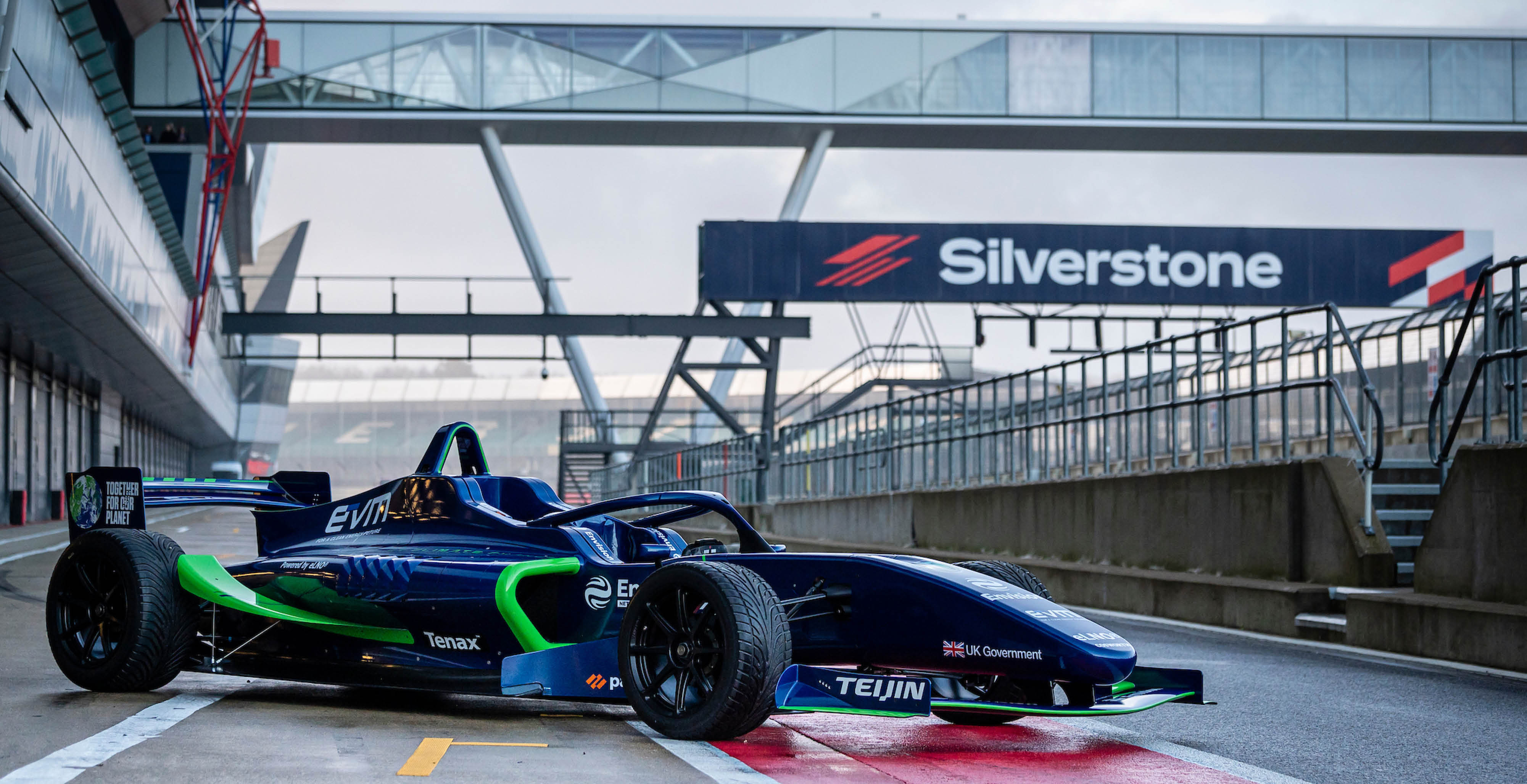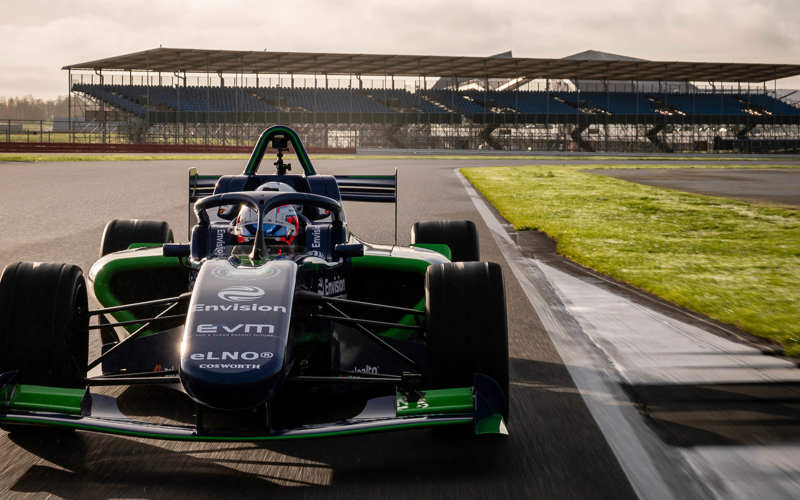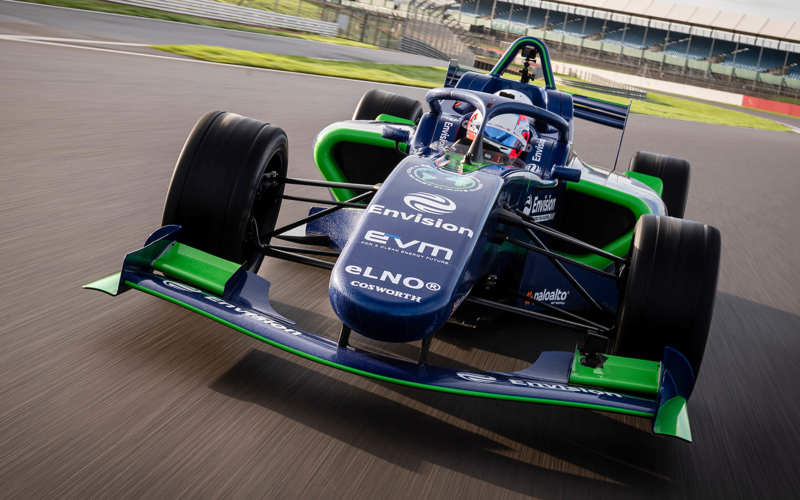At Cosworth, we are well acquainted with the demands of developing and delivering mission-critical solutions on an international stage. We know what it takes to create cutting edge, industry-leading technology, especially where time, quality and high-performance are essential components.

OVERVIEW
When the Envision Racing Formula E team set out to develop the world’s first-ever electric two-seater car, we were ready for the challenge. The introduction of the two-seater was, however, far more than just another race car; this high-tech vehicle was intended to act as an extension of the team’s Race Against Climate Change sustainability programme, aimed at inspiring generations to tackle climate change.
From scratch, this one-of-a-kind prototype would be designed, developed, and constructed in just six months, in time for its global debut at the 2021 UN Climate Change Conference, COP26. With the world watching, the race was on…
CHALLENGES
When we start a new project from the wheels up, the challenges are vast: attention to detail, meticulous planning, working cohesively as a team, and in this case within ambitious time constraints. It’s in situations like this where we thrive.
Envision Racing was clear that the design should not replicate a Formula E car, but instead had to resemble a more typical Formula vehicle which required attention to styling. This approach fostered a deep collaboration between Cosworth and the Envision Racing team to ensure the final product met expectations, aesthetically and technically.
Experience is everything with a two-seater, so our focus centred on the attributes of the car that delivered performance, primarily acceleration, without compromising the sustainability message. We were tasked with integrating the Formula E powertrain into a bespoke car that brought together the complete array of our expertise – with timely delivery, reliability, and ultimate performance: a challenge ideally positioned for Cosworth!
SOLUTIONS
Our battery specialists at Cosworth Advanced Technologies are accustomed to working on full vehicle projects like the Envision Racing two-seater. We combined their experience with the talents from across the Cosworth Group to tackle this unique project.
With the clock ticking to COP26, our work had to be methodical with impeccable project management at the core of everything. Formula E cars exist to be raced competitively so getting to the heart of technical intricacies required close co-operation with powertrain and gearbox suppliers. We needed the right information in a timely manner to begin the car specification.
The first step was to design the carbon fibre monocoque, which provided the base into which we could incorporate all the car’s features, including bodywork, packaging areas for mounting controllers, ECUs, and the steering rack. We then had to explore the powertrain and the suspension design. Every detail was considered, even the wheels; our engineers worked closely with a wheel supplier to produce a custom-wheel design to fit the track-width of the car, and to be capable of withstanding the torque generated by the powertrain.
One of the biggest project management challenges was accruing the data for the Formula E powertrain. As the components used are normally built to be raced competitively, teams and manufacturers are reluctant to give out detailed technical information. As a result, there was a lot of trusted collaboration with powertrain and gearbox suppliers to ensure that we were getting the right level of information for the unit that we were using; when we powered the vehicle for the first time, we knew it would perform as expected.
The battery pack uses non-standard format, high-energy high-power cells. The eLNO cells which feature nickel-rich cathode material technology, were developed and supplied by Envision’s title sponsor, EVM. To ensure we configured the pack correctly, we used our tried and tested cell categorisation process to maximise their performance and optimise cooling.
A huge amount of cell testing took place as part of the categorisation process. From thermal hazard testing - making sure we had a full understanding of how the cells respond if they exceed the upper temperature limits - to how the cells behave if a short circuit were ever to occur. We were able to use our combined knowledge from developing prototype battery packs, prototype vehicles, as well as working with this kind of a specialist prototype cell to deliver a highly capable and optimised pack.
We also developed the battery management and vehicle control systems to extract performance and maximise reliability: from driver inputs all the way through to battery and motor cooling.
Cooling the battery pack in a highly efficient manner is key to running a safe performance vehicle. We designed a bespoke cold plate-based cooling system, fitted between the battery cells. We then control the system from the vehicle controller using the feedback from the Battery Management System (BMS). The BMS measures all cell temperatures and voltages across the entire pack, making sure that these parameters are uniform across the board. The temperature is controlled using this data by changing the speed of the coolant flow to the cold plates and radiators.
For ease of use, we integrated systems that are used as standard in Formula E. For example, we took the Formula E charger, and its necessary components, and wrote software that enabled this integration. This allows the team to extract the charging diagnostic data that they are used to accessing when running their Formula E cars.
The support team from Cosworth Electronics also had significant input. The car uses our CFW steering wheel, however it wasn’t just a case of bolting it on and running with it. The wheel required custom software to give the driver control of the different parameters needed in this EV application, for example an EV specific alarm and a view of battery cell voltages.
Suspension geometry is another big development area for a new car. We were free to design the front of the car how we wanted, as we also designed the monocoque to which the suspension is mounted. However, at the rear of the car, we had to incorporate our suspension design into the powertrain. To get an accurate base, we 3D-scanned the gearbox and other key areas to ensure our pickup points were perfect. From there we took our advanced knowledge of motorsport level suspension design and developed a system that complements the characteristics of the rest of the car.
In motorsport, safety is always of paramount importance. We used top level FIA regulations to dictate our safety structures. We have similar intrusion and crash structures to those currently used in Formula 1, using Zylon in crucial areas of the bodywork and chassis to prevent intrusions to the cockpit in the event of a crash.
Weight is less of a priority on an experience car, as it is not competing against a grid of fierce rivals. This enabled us to add an extra margin of safety over a comparable competition car. Nonetheless we have developed a vehicle that can carry two people, 40kg under the minimum weight of a homologated Formula E car: a testament to our expertise in lightweight structures and design – and a fantastic technical showcase for Envision Racing on a global stage.

